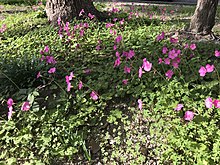bio.wikisort.org - Plant
Oxalis articulata, known as pink-sorrel,[1] pink wood sorrel,[2] windowbox wood-sorrel, Chari amilo (Nepal),sourgrass[3], Netho (khatta) saag (India)[4] is a perennial plant species in the genus Oxalis native to temperate South America.[5] It has been introduced in Europe in gardens and is now naturalized in these areas.
| Oxalis articulata | |
|---|---|
 | |
| Scientific classification | |
| Kingdom: | Plantae |
| Clade: | Tracheophytes |
| Clade: | Angiosperms |
| Clade: | Eudicots |
| Clade: | Rosids |
| Order: | Oxalidales |
| Family: | Oxalidaceae |
| Genus: | Oxalis |
| Species: | O. articulata |
| Binomial name | |
| Oxalis articulata Savign. (1798) | |
| Subspecies | |
| |
| Synonyms | |
|
Oxalis rubra | |

The plant is susceptible to rust (disease due to the fungus Puccinia oxalidis).[6]
- O. articulata f. crassipes
- O. articulata ssp. rubra
Description
As the name would imply, this species of Oxalis typically has pink to violet flowers[7] with petals 10–15 mm long.[8] This species has "Plants arising from a thick, woody, irregularly nodulate-segmented rhizome often with persistent, thickened, and lignescent petiole bases; flowers 3–12 in umbelliform cymes, less commonly in irregular cymes".[9] The plant is a perennial and typically grows up to 45 cm tall[7] and 2 cm in diameter.[5] It spreads by rhizomes (up to 15 cm[10]) to form colonies.[2] It is hermaphrodite and also infrequently produces seeds in long, cylindrical capsules.[11]
Uses
Oxalis articulata has a large amount of ascorbic acid and is eaten as a vegetable by inhabitants of Jharkhand, India.[4]
Oxalis articulata can be used as ground cover in green zones to inhibit the growth of weeds in such areas and alleviate the need for herbicide. This is due to the allelopathic leachates in the leaves and exudates from the roots of living Oxalis plants which display significant inhibitory activities on the growth of other plants.[12] Oxalate extracts from the leaves have been shown to exhibit anti-fungal properties.[13]
Ornamental use
Oxalis articulata is used as an ornamental in Turkey[citation needed] and China.[14] The plant is not drought tolerant and soil should be kept moist. It grows best in acid or light soils. Oxalis articulata is more competitive than other species in this family, and can tolerate plant beds which are loosely populated with other greenery. However, it thrives in disturbed ground.[5] Though it is hardy, it grows best in warmer areas.[5] It flowers continuously from throughout the warmer months and goes dormant at first frost.[15] Out of the sun, the flowers roll up into a tube-like shape.[16]
Control
It is regarded as a weed in many places, including South Australia, New South Wales, and Victoria.[17] As it spreads through rhizomes, care should be taken when removing to avoid leaving behind bulbs. Digging the bulbs out while soil is moist when removing can help this process.[18]
See also
- List of the vascular plants of Britain and Ireland 6
- List of plants in the Gibraltar Botanic Gardens
- Oxalis tetraphylla, the four-leaved pink-sorrel
References
- BSBI List 2007 (xls). Botanical Society of Britain and Ireland. Archived from the original (xls) on 2015-06-26. Retrieved 2014-10-17.
- "Oxalis articulata subsp. rubra". Missouri Botanical Garden. Retrieved April 20, 2019.
- "Oxalis articulata (Pink sorrel)". T.E.R.R.A.I.N. Retrieved 2019-04-19.
- Gupta, Sakshi; Srivastava, Anuradha; Lal, Eugenia (2017). "Food and Nutritional Security through wild edible vegetables and weeds in two district of Jharkhard, India". Journal of Pharmacognosy and Phytochemistry. 6: 1402–1409.
- Young, D (1958). "Oxalis in the British Isles". Watsonia. 4: 51–69.
- Tavares, Silvia; Ramos, Ana Paula; Pires, Ana Sofia; Azinheria, Helena; Caldeirinha, Patricia; Link, Tobias; Abranches, Rita; Do Céu Silva, Maria; Voegele, Ralf (2014). "genome size analyses of Pucciniales reveal the largest fungal genomes". Frontiers in Plant Science. 5: 422. doi:10.3389/fpls.2014.00422. PMC 4143883. PMID 25206357.
- Ghahremaninejad, F; Gholamian, F (2006). "A new record (Oxalis Articulata) from Iran". Iranian Journal of Botany. 12: 55–56.
- "Oxalis articulata Savigny". PlantNET.
- Horne, Howard; Barger, Wayne; Nesom, Guy (2013). "Two South American species of Oxalis (Oxalidaceae) naturalized in Alabama and the USA, first report". Phytoneuron. 54: 6.
- "Oxalis articulata". Useful Tropical Plants. Retrieved April 18, 2019.
- Nelson, John (April 5, 2017). "Mystery Plant: Oxalis articulata". The Herald Sun. Retrieved April 19, 2019.
- Shiraishi, Sakaya; Watanabe, Izumi; Kuno, Katsuji; Fujii, Yoshiharu (2005). "Evaluation of the allelopathic activity of five Oxalidaceae cover plants and the demonstration of potent weed suppression by Oxalis species". Weed Biology and Management. 5 (3): 128–136. doi:10.1111/j.1445-6664.2005.00167.x.
- Shiraishi, Sayaka; Watanabe, Izumi; Kuno, Katsuji; Ishii, Hideo; Fujii, Yoshiharu (2003). "Soil drenching with water extracts of Oxalis articulata Savigny suppress Fusarium wilt of tomato". Weed Biology and Management. 3 (3): 184–188. doi:10.1046/j.1445-6664.2003.00102.x.
- Wang, LY; Jin, FM; Jin, YJ; Xui, JQ; Wen, W; Chen, JH; Ye, D (February 2018). "Responses of underground clonal storage to mowing of the alien clonal weed species Oxalis articulata". Yingyong Shengtai Xuebao. 29 (2): 501–506. PMID 29692064.
- JÁNOS, ÁGOSTON (2016). "Investigation of the ornamental value of Bulbous Oxalis species and cultivars". Lucrări Ştiinţifice. 1: 5–10.
- "Pink-Sorrel, Oxalis articulata". Wild Flower Finder. 2016. Retrieved April 20, 2019.
- "Oxalis Articulata Savigny". Queensland Government. Retrieved April 19, 2019.
- "Wood-sorrel (Oxalis articulata)". Eurobodalla Shire Council. Retrieved April 20, 2019.
External links
Другой контент может иметь иную лицензию. Перед использованием материалов сайта WikiSort.org внимательно изучите правила лицензирования конкретных элементов наполнения сайта.
WikiSort.org - проект по пересортировке и дополнению контента Википедии



